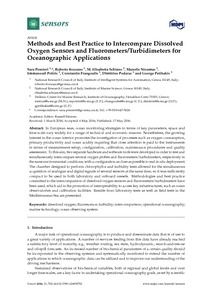| dc.contributor.author | Pensieri, Sara | |
| dc.contributor.author | Bozzano, Roberto | |
| dc.contributor.author | Schiano, M. Elisabetta | |
| dc.contributor.author | Ntoumas, Manolis | |
| dc.contributor.author | Potiris, Emmanouil | |
| dc.contributor.author | Frangoulis, Constantin | |
| dc.contributor.author | Podaras, Dimitrios | |
| dc.contributor.author | Petihakis, George | |
| dc.date.accessioned | 2018-06-22T22:38:41Z | |
| dc.date.available | 2018-06-22T22:38:41Z | |
| dc.date.issued | 2016 | |
| dc.identifier.citation | Pensieri, S.; Bozzano, R.; Schiano, M.E.; Ntoumas, M.; Potiris, E.; Frangoulis, C.; Podaras, D.and Petihakis, G. (2016) Methods and Best Practice to Intercompare Dissolved Oxygen Sensors and Fluorometers/Turbidimeters for Oceanographic Applications. Sensors, 16:702 [pp.1-25]. DOI: https://doi.org/10.3390/s16050702 | en_US |
| dc.identifier.uri | http://hdl.handle.net/11329/433 | |
| dc.identifier.uri | http://dx.doi.org/10.25607/OBP-19 | |
| dc.description.abstract | In European seas, ocean monitoring strategies in terms of key parameters, space and
time scale vary widely for a range of technical and economic reasons. Nonetheless, the growing
interest in the ocean interior promotes the investigation of processes such as oxygen consumption,
primary productivity and ocean acidity requiring that close attention is paid to the instruments
in terms of measurement setup, configuration, calibration, maintenance procedures and quality
assessment. To this aim, two separate hardware and software tools were developed in order to test and
simultaneously intercompare several oxygen probes and fluorometers/turbidimeters, respectively in
the same environmental conditions, with a configuration as close as possible to real in-situ deployment.
The chamber designed to perform chlorophyll-a and turbidity tests allowed for the simultaneous
acquisition of analogue and digital signals of several sensors at the same time, so it was sufficiently
compact to be used in both laboratory and onboard vessels. Methodologies and best practice
committed to the intercomparison of dissolved oxygen sensors and fluorometers/turbidimeters have
been used, which aid in the promotion of interoperability to access key infrastructures, such as ocean
observatories and calibration facilities. Results from laboratory tests as well as field tests in the
Mediterranean Sea are presented. | en_US |
| dc.language.iso | en | en_US |
| dc.rights | Attribution 3.0 IGO | * |
| dc.rights.uri | http://creativecommons.org/licenses/by/3.0/igo/ | * |
| dc.subject.other | Dissolved oxygen | en_US |
| dc.subject.other | Fluorescence | en_US |
| dc.subject.other | Turbidity | en_US |
| dc.subject.other | Intercomparison | en_US |
| dc.subject.other | Operational oceanography | en_US |
| dc.subject.other | Ocean observing system | en_US |
| dc.subject.other | Marine technology | en_US |
| dc.title | Methods and Best Practice to Intercompare Dissolved Oxygen Sensors and Fluorometers/Turbidimeters for Oceanographic Applications. | en_US |
| dc.type | Journal Contribution | en_US |
| dc.description.refereed | Refereed | en_US |
| dc.format.pagerange | 702;, pp.1-25 | en_US |
| dc.identifier.doi | https://doi.org/10.3390/s16050702 | |
| dc.subject.parameterDiscipline | Parameter Discipline::Chemical oceanography | en_US |
| dc.subject.instrumentType | Instrument Type Vocabulary::dissolved gas sensors | en_US |
| dc.subject.instrumentType | Instrument Type Vocabulary::fluorometers | en_US |
| dc.bibliographicCitation.title | Sensors | en_US |
| dc.bibliographicCitation.volume | 16 | en_US |
| dc.bibliographicCitation.issue | 5 | en_US |
| dc.description.eov | Oxygen | en_US |
| dc.description.bptype | Best Practice | en_US |
| dc.description.bptype | Guide | en_US |
| obps.contact.contactemail | sara.pensieri@ge.issia.cnr.it; | |
| obps.resourceurl.publisher | http://www.mdpi.com/1424-8220/16/5/702 | en_US |
 Repository of community practices in Ocean Research, Applications and Data/Information Management
Repository of community practices in Ocean Research, Applications and Data/Information Management

